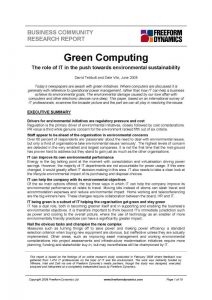A prophetic look back at Green IT
Back in the summer of 2008, we surveyed almost 1500 IT professionals regarding IT and the environment. While many of the research findings still very much apply today, little did we know that some of the front page results would prove remarkably prophetic for the year 2020, albeit for totally different reasons.
As our contribution to the bit of fun that is Throwback Thursday, we’re taking a weekly stroll in the Freeform Dynamics archives.
When looking at the wider picture, many of the major factors driving environmental initiatives in 2008 are still valid today. Back then regulatory pressures along with legislation were cited as being significant triggers for change and remain high on agendas today.
The other big factor thrown up by the survey results will surprise no one, namely costs. In particular, the cost of electrical power – both for systems and for the data centre fabric – was finally beginning to catch the eye of accountants. Nothing has changed today except that the information available on power usage inside the data centre is more readily available. When this is combined with the huge growth in data centre systems and storage, the need for power efficiency is clear.
The entire lifecycle is what matters
But alongside power efficiency, the report also mentioned that it was important for IT, and the business in general, to consider the bigger environmental picture. This explicitly included the suggestion that IT should look at the environmental impact of the entire lifecycle of systems. That is, from component procurement, through system assembly to the end-of-life reuse or recycling of kit.
Today, many vendors now take steps to demonstrate the carbon credentials of their IT systems over the entire lifecycle, from build to end-of-life. Sadly, the study showed that employees were far more likely to be motivated by such ideas than the organisations they worked for.
Carbon savings that came to pass
So, what were the prophecies in the 2008 paper? The report’s executive summary page indicated that there were three ways IT could help improve the company’s environmental impact. Two were travel related: they suggested making more use of home working, and that teleconferencing had the potential to reduce the carbon footprint.
The third was the acknowledgement that HR, senior board members and line managers would need to collaborate to make this happen broadly. Step forward to 2020, and the use of collaboration tools, home working and teleconferencing have all become mainstream – even though carbon reduction was not in fact the primary driver.
If you have a few minutes to step back in time and see how much, or how little, has changed, download the report and take a look.




